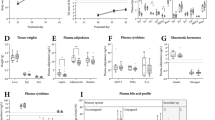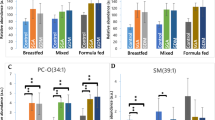Abstract
Both protein-energy malnutrition (PEM) and obesity represent major challenges for paediatric nutrition. The aim of this review is to summarise available data regarding the effect of PEM and obesity on the availability of essential- and long-chain polyunsaturated fatty acids (LC-PUFAs) in childhood.
Significantly lower arachidonate (C20: 4n-6, AA) values in malnourished children than in controls is a consistent finding in all studies, whereas it is controversial whether the availability of docosahexaenoate (C22: 6n-3, DHA) is also affected. We found significantly lower percentages (% wt/wt) of both AA and DHA in plasma phospholipids [AA: 7.0 (0.7) vs 8.7 (0.8); DHA: 0.90 (0.2) vs 2.6 (0.7), median (interquartile range), P<0.001] in severely malnourished children aged 29 (7) months than in control subjects. Product/substrate ratios indicated reduced delta-5-desaturation in children with PEM. We speculate that severely malnourished children may benefit from enhanced dietary supply of both n-6 and n-3 LC-PUFAs.
In obese adults AA has been reported to constitute a lower percentage of plasma phospholipid fatty acids, and AA supplementation of weight reduction diets has been suggested. In contrast, we found significantly higher plasma phospholipid AA values [12.6 (2.4) vs 8.3 (1.4), P<0.001] in markedly obese children aged 13.8 (1.1) years than in non-obese controls. Product/substrate ratios of the delta-6-desaturase enzyme indicated enhanced conversion activity. These data suggest that obese children do not require LC-PUFA supplementation to low fat diets.
The available data indicates that both PEM and obesity alter fatty acid composition of plasma and erythrocyte membrane lipids. The underlying mechanism appears to be altered activity of the bioconversion of essential fatty acids to their LC-PUFA metabolites.
Sponsorship: Hungarian National Research Fund and the Hungarian Ministry of Welfare, Budapest, Hungary; and Deutsche Forschungsgemeinschaft, Bonn, Germany.
This is a preview of subscription content, access via your institution
Access options
Subscribe to this journal
Receive 12 print issues and online access
$259.00 per year
only $21.58 per issue
Buy this article
- Purchase on Springer Link
- Instant access to full article PDF
Prices may be subject to local taxes which are calculated during checkout
Similar content being viewed by others
Author information
Authors and Affiliations
Rights and permissions
About this article
Cite this article
Decsi, T., Molnár, D. & Koletzko, B. The effect of under- and overnutrition on essential fatty acid metabolism in childhood. Eur J Clin Nutr 52, 541–548 (1998). https://doi.org/10.1038/sj.ejcn.1600607
Published:
Issue Date:
DOI: https://doi.org/10.1038/sj.ejcn.1600607
Keywords
This article is cited by
-
Fatty acid composition of erythrocyte membrane lipids in healthy subjects from birth to young adulthood
European Journal of Pediatrics (2009)
-
Metabolic Syndrome Affects Fatty Acid Composition of Plasma Lipids in Obese Prepubertal Children
Lipids (2008)
-
Polyunsaturated fatty acids in plasma lipids of obese children with and without metabolic cardiovascular syndrome
Lipids (2000)



